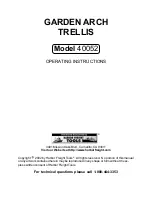
Section 3: Operating Procedures
12/18/19
AP-SC2560 & AP-SC2572 Skid Steer Rotary Cutter 326-836MK
26
General Operating Instructions
It is absolutely essential that you read and understand
both the Operator’s Manual for Kubota’s skid steer Rotary
Cutter and the Operator’s Manual for the skid steer unit
you intend to attach it to before attempting to operate or
cut with this combination of equipment. You must be able
to read, comprehend, and adhere to all safety warnings
and decals in order to avoid personal injury, fatalities,
injury to others, or costly damage to property and
equipment. We highly recommend that you be a skilled
and competent skid steer operator prior to attaching and
attempting to use the skid steer Rotary Cutter. If there is
any part of the information above or safe operating
procedures you do not understand, please contact your
nearest authorized dealer for a full explanation and
training session if necessary.
Skid Steer Operating Instructions
Assuming you have met all of the above requirements
and taken them seriously, it is time to take the next step
and that is accomplished by dressing appropriately for
the task. You will need to put on protective eye wear such
as safety glasses, goggles, or a face shield. A hard hat,
steel toed safety shoes, gloves, and hearing protection
are also highly recommended. Never wear loose fitting
clothing and you may want to put on a respirator or filter
mask to avoid breathing in dust, pollen, or agriculturally
used toxins that may be present.
The next step is a static or non-running pre-inspection of
the skid steer unit. You will want to make sure that the
skid steer is equipped with a fully functioning ROPS (Roll
Over Protection System) which does include seat belts
and an operator safety enclosure. The cab must also be
equipped with a polycarbonite door, which may have
been supplied with the skid steer unit. Kubota does offer
a protective door with the SC2560 and SC2572 if one is
not provided by your skid steer supplier. If the skid steer
is to be operated on local roadways, it must be equipped
with appropriate Slow Moving Vehicle (SMV) and other
required lighting packages so as to make it compliant
with state and local department of transportation
requirements. The cutter drive motor must be matched to
the output of the hydraulic capacity of the skid steer.
Failure to do this could result in serious over-speeding of
the cutting unit possibly resulting in serious injury,
fatalities, or property damage. The universal quick-hitch
mount should be in good working order and latches
should be located to the open position. There should be
no evidence of hydraulic leaks in and around the auxiliary
hydraulic couplers. There must be a readily accessible
attaching point for the Rotary Cutter lift-limit chain on the
lower front portion of the chassis frame. Finally make
sure that all shields and safety features are in place and
fully functional.
The next step is to perform a running check of the skid
steer unit. As you get onto the skid steer and into the
operator’ compartment always use factory provided
hand-holds and don’t grab the steering or control levers to
ease or stabilize your entry. Fasten your seat belt once
you are seated and begin to mentally orient yourself with
the position of all controls, switches, pedals, levers, and
their related functions. Once you are sure that the park
brake is on, no people or animals are in close proximity,
all control levers, pedals, and hydraulic systems are in
neutral position, go ahead and start the engine. With the
engine now running and the throttle at approximately one
third, test all controls to make sure they are fully
functioning. If at any time there is an equipment failure,
shut the unit down and make immediate and full repairs.
Rotary Cutter Operating Instructions
Assuming all systems with the skid steer are “go” and
fully functioning, it is time to connect to the SC2560 or
SC2572 Rotary Cutter. This is done by maneuvering the
skid steer mounting plate into position under the
universal quick mount hitch saddle. Once this is
accomplished and the mower is fully supported by the
skid steer lift arms, lower mower to a point approximately
two inches above ground. Turn the engine off, set the
parking brake, and climb out of the skid steer. Lock the
latch handles down to engage the hitch pins. Make the
appropriate hydraulic connections to the auxiliary
hydraulic outlet and case drain making sure to keep
connectors clean. Be sure to use proper fittings and if
connection is difficult, moving levers may help relieve line
pressure. (Note! Hydraulic flow direction on all skid steers
is not the same. Make sure hoses are connected properly
or blades will rotate at a much slower speed.) Wipe away
spilled or excess hydraulic oil and secure Cordura
sleeves to contain potential leaks. Connect the height
limiting safety chain to the chassis attaching point and
restrict cutting height to no more that eighteen inches.
This completes the attachment of the cutter to the skid
steer.
The next step is to complete a pre-operation check of the
cutter. Make sure all guards, safety shields, safety
chains, and deflectors are in place. All hardware must be
in place and appropriately tightened. Damaged, severely
worn, or defective parts must be replaced prior to
operation. If your unit is equipped with the optional front
mounted gauge wheel, you will want to adjust it for
desired cutting height at this time.
You should always inspect the area where you intend to
cut for debris and hazards located on the ground. No one,
including people and animals, should be allowed within
100 yards of this cutter when in operation. If someone
does approach, shut the cutter down immediately. The
blades on this cutter should never be allowed to come in
contact with objects such as wire, cable, rope, or chains
that might become entangled. These types of entangled
objects can become extremely hazardous by rotating
outside of the cutter deck housing resulting in serious
injury or death. Always inspect the area before you mow.















































